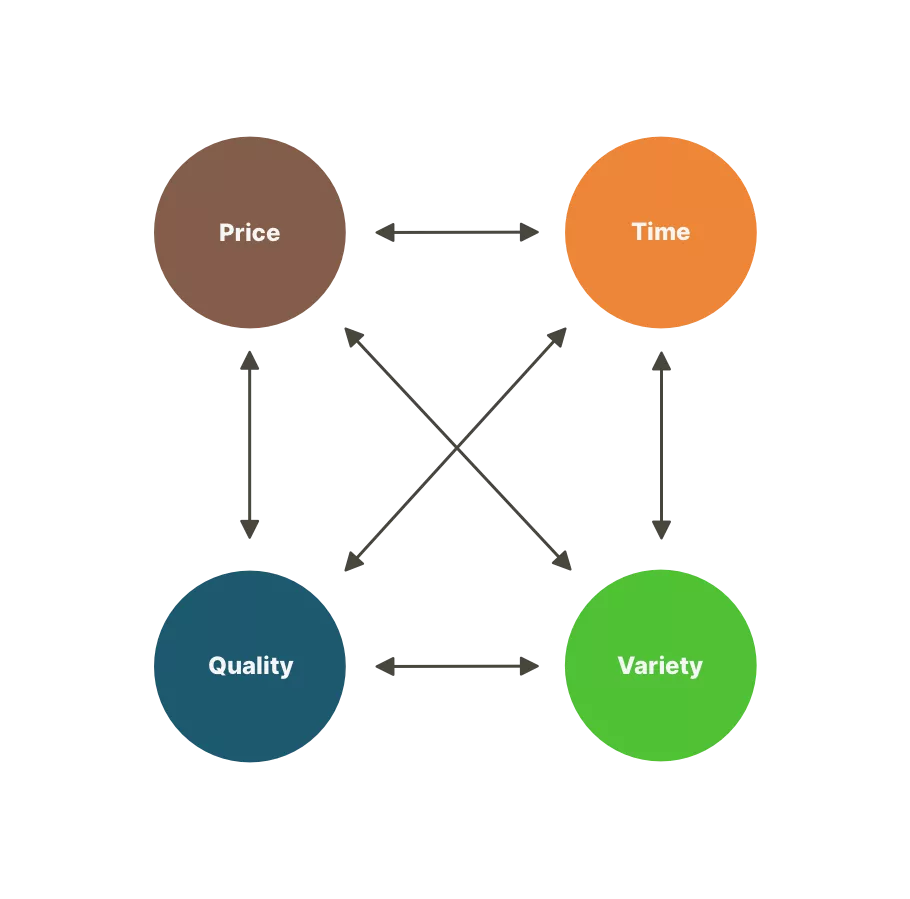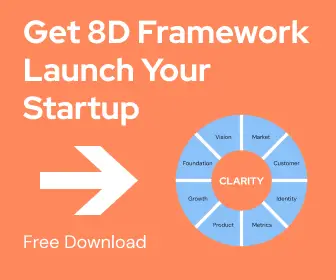Hey! We’re not gonna talk in this article about why your business needs proper differentiation and positioning, and a strong USP (feel free to check these articles, though, and then get back here).
Here’s a simple and powerful way to think about your positioning: Price, Time, Quality, or Variety. These are the ultimate customer benefits that drive their final buying decisions.
Learn from the Giants!
This framework was perfectly described by Professor Gad Allon in his studies and implemented by the best world companies that play big games (you’ll see those examples below, just be patient).
We have explored, summarized, and enriched these approaches for you so that as an entrepreneur you wouldn’t have to spend time on theory. We know you’re busy.
Positioning Framework
So, here are those customer benefits:
| Focus | Audience | Values |
|---|---|---|
| Price | Counts their money: doesn’t want to overpay for having their problems solved. They are willing to wait, lower their quality expectations and to thoroughly search around the cheapest option. | You offer them the best price on the market. In fact, they want to hear “value for money” (good quality at a reasonable price). |
| Time | In a hurry: they want a lot and they want it yesterday. They are OK to pay more if the offering is good enough but very quick. | With your help, they will save a ton of time. It’s not only about fast delivery; it’s about ease and convenience throughout the entire buying and using experience. |
| Quality | Believes that they deserve only (!!!) the best: They are willing to pay a premium for superior products, services, and experiences. They are OK to wait and to spend time finding the best expert in a specific area. But they won’t forgive your mistakes. | You provide them with the best quality. Moreover, you provide the highest quality of product, service, problem resolution, and overall customer experience. |
| Variety | Wants to come to one shop and buy everything that they need today. They are happy to repeat and return to find something new. They are OK if the prices are higher than average. OK if they will have to wait for the delivery, and the quality does not have to be perfect. | You are the one-stop solution for them. They can purchase a wide range of products at your place. With services, they can delegate the problems to you and simply forget about them. |
Don’t Boil the Ocean

Very often, the things you need to do to reach these 4 goals conflict with each other
- Take Price and Quality: To be the absolute price leader, you inevitably have to cut costs somewhere, which will drop down Quality.
- Having a maximum Variety of options often means increased complexity in your operations, which significantly slows you down (Time).
Your competitors are welcome to boil the ocean and do everything for everyone!
In fact, you don’t have to:
- Being excellent in multiple areas means huge investments in time, money, and talent. Let your competitors waste it.
- Positioning: you can concentrate your resources on one or two things while they won’t match the same level of quality, speed, price, or variety that you offer.
- Targeting: you can focus on those specific clients who will really value your efforts and offerings.
People are all different. In fact, they won’t believe you if you claim you have the lowest price, you are the fastest, and bring the best quality of all possible products. All at the same time. Oh, come on…
Clear Marketing Message
Be honest with your clients!
Clarity of the marketing message should be realistic and consistent with your brand image.
Companies that truly excel become known for something specific and build strong reputations within their chosen niche. They find their strategic positioning in 1 or 2 of those things: Price, Time, Quality, or Variety. Abstract examples:
- The Convenience Champion: You may not have the cheapest products, but you offer lightning-fast delivery, 24/7 support, and easy returns.
- The Experience Expert: You provide a smaller selection of high-quality goods, and every customer gets in-depth advice to find their perfect match.
Important note: No one buys from the cheapest store if the service is just terrible. Or from the highest-quality provider if delivery takes forever. So, please, be minimally competent (good enough) in the other areas as well.
Real World Examples
Price-Focused Companies
- Walmart: They’re laser-focused on keeping prices low. Every. Single. Day. That’s why they buy in bulk, ship stuff efficiently, and run lean operations. Basically, ninjas of saving you money.
- IKEA: Stylish furniture at prices most people can afford. That’s IKEA. They keep it flat-packed for cheap shipping, maximize self-service (good exercise!), and offer decent quality for the price. It’s like grown-up Legos but for your living room.
- Ryanair: Wanna fly across Europe for the lowest possible airfares? Ryanair is your crew. They charge extra for everything, use smaller secondary airports, and keep a standardized fleet of planes to save on maintenance costs.
- Dollar Tree: Everything is literally a dollar (or very close!) They find all kinds of random stuff – closeouts, leftovers from other stores – and make it cheap. It’s like a treasure hunt for bargain shoppers.
- Kia/Hyundai: These Korean cars offer excellent value for money. You get stylish cars packed with the gadgets you want. And the best part? Way cheaper than those fancy Japanese or European brands.
Time/Convenience-Focused Companies
- Amazon (and their Prime): They’re competitive on other fronts too, but they really rule the online shopping world. Prime means your stuff arrives super fast, they have a ton of choices (Variety as well), and it’s super easy to order.
- Domino’s Pizza: Let’s be honest, their pizza isn’t winning any fancy awards. But ordering is a breeze (app, website, or just call them!) It shows up quickly, and you always know what you’re gonna get. Sometimes, that’s all you need when you’re starving.
- Uber/Lyft: These guys changed how we get around. Tap the app, and a car arrives within minutes. Might not always be the cheapest, but you gotta admit, it’s easy.
- FedEx is known for its fast and trustworthy package delivery service. They’re all about speed and getting your package where it needs to be, no matter what.
- Fast food chains (McDonald’s, Burger King, etc.): You don’t go there for fine dining, right? But hey, sometimes you just need a burger and fries. Drive-thru, grab a quick bite, and you’re back on the road. Fast and satisfying.
Quality-Focused Companies
- Apple: Their products are not cheap. But you’re paying for that sleek design, premium feel, and the fact that everything just works smoothly.
- Rolex: Definition of luxury. Meticulous craftsmanship, precious materials, and an enduring reputation for quality. Be prepared to shell out some serious cash, though.
- Lego: Yup, there are cheaper building block options. But LEGO just feels better! They’re built to last, get super creative with themes and play systems. Even we, adults, can’t resist playing with them. That quality keeps them on top.
- Tesla: These electric cars are a whole different game. They’re fast, safe, and packed with cool tech features. They’re serious about performance, innovation, and quality. And that’s why they’re not cheap!
- Lexus: Think of it as Toyota, but way more luxurious. Flawless build quality, premium materials, and a focus on comfort and quietness.
- Michelin-starred restaurants: Okay, this is about the experience, not just the food. Exceptional ingredients, dishes prepared with unbelievable skill, and a memorable atmosphere. Be prepared to pay for that experience.
Variety-Focused Companies
- eBay: This online place is like a massive online flea market with a huge selection of new and used goods. They don’t claim to be the fastest or cheapest, but sometimes you gotta dig for those unique items.
- Netflix: They started with DVDs (remember those?) mailed to your door. Today, they rule the streaming world. Tons of movies and shows, always changing things up.
- Shein: New clothes… all the time. It’s like fashion on hyperspeed. They keep it cheap (great Price is there as well) and drop new stuff constantly. They win on the rapid turnover of their assortment.
- Etsy: This online marketplace is a treasure trove of unique, handmade, and vintage items. Their strength lies in a vast selection that can’t be replicated by mass retailers.
- Ford: They offer cars, trucks, SUVs… basically, something for everyone. You might not find the most cutting-edge or niche car there, but they’re a solid choice for that one-stop-shop feel.
Marketing Strategy
That’s how you can design your marketing strategy and USP depending on your key positioning.
| Marketing Emphasis | Target Audience | Messaging | Channels | Promotions | Considerations |
|---|---|---|---|---|---|
| Price | Budget-conscious folks, families, or anyone for whom price is the primary factor. | Emphasize value for money and cost savings. Highlight any price match guarantees or special deals. Use terms like “bargain,” “discount,” and “affordable.” | Use price comparison websites, social media ads with clear pricing information, email marketing with promotions, and discounts. | Frequent sales, loyalty discounts, and bundle offers to reinforce the value. | Be careful: Avoid appearing “cheap.” Emphasize value for money, not just the lowest possible cost. |
| Time | Busy individuals, people who need last-minute solutions, or those who prioritize convenience above all else. | Focus on speed, ease, and efficiency. Highlight how the product or service saves time or simplifies the customer’s life. Use phrases like “instant,” “fastest,” “on-demand,” “same-day delivery,” or “skip the wait.” | Digital advertising emphasizing quick delivery or fast service, mobile marketing, and strategic placements on platforms used by time-sensitive consumers. | Offering expedited shipping, instant rebates for quick purchases, or emphasizing limited-time offers to create urgency. | Demonstrate your advantage: Use visuals (e.g., a timeline of the old vs. new way of doing things) or customer testimonials highlighting the time saved. |
| Quality | Those seeking the best, willing to pay a premium for superior products, services, and experiences. | Focus on craftsmanship, superior materials, excellence, and exclusivity. Use descriptive words like “premium,” “finest,” “meticulous,” or “long-lasting.” | High-quality content marketing (like videos and blogs), influencer and expert partnerships, and advertising in premium environments such as luxury magazines and websites. | Less emphasis on discounts; instead, offer exclusive experiences or complementary premium services. | Luxury brand? Don’t even talk about the price! Explain the superior quality and experience. |
| Variety | Busy consumers who appreciate multiple options, flexibility, personalized products and services, and single-vendor experience. | Emphasize the breadth and depth of the product line. Show how extensive choices can cater to individual preferences and needs. Use phrases like “unlimited options” or “discover the possibilities.” | Online marketing with SEO strategies focused on long-tail keywords to capture diverse consumer interests, targeted ads showcasing the range of options. | Cross-promotions within the range, showcasing combinations or how different products can meet various needs. | Encourage customers to try new things, experiment, or express their unique tastes. Make sure your website or store has clear navigation and search functions so customers can easily find what they need. |
Operations Strategy
– Oh, are we going to talk about operations as well? I thought it was only about marketing!
– Yesss, please. Check this one too –
Thing is, if your marketing promises one value but your business excels at a different one – clients will notice it in the end. This will be disruptive for you in the long run. Your ‘back end’ must consistently deliver on your promise.
Your operations strategy is how you do your business inside of the black box.
It’s something that a client won’t see at first glance but they experience it when they buy from you.
Be honest with yourself!
Decide which competencies you should improve in your operations based on your key positioning.
Cost-Strategy
- Efficiency and Cost Control: Minimize waste and overstock and reduce costs. Use economies of scale to negotiate better terms with your suppliers.
- Supply Chain Optimization: Develop a lean supply chain that reduces inventory costs and improves turnover rates. Consider outsourcing non-core activities to more cost-effective partners.
- Technology Utilization: Invest in technology that automates routine tasks and lowers labor costs. Implement systems that provide real-time data on inventory and sales to fine-tune purchases and production.
- Scaling Matters: Achieving those low prices often relies on the volume of sales.
Speed-Strategy
- Process Optimization: Reduce cycle times. Simplify procedures, remove bottlenecks, and implement just-in-time manufacturing.
- Speed and Responsiveness: Operations must prioritize rapid turnaround time, whether it’s manufacturing speed, fast shipping, or streamlined order processing. Duplicate to ensure speed!
- Advanced Logistics: Invest in a robust logistics system that supports rapid delivery, including state-of-the-art warehousing facilities and effective transportation management systems.
- Customer-Centric Systems: Develop IT systems that facilitate quick order processing, real-time tracking, and efficient customer service, enhancing overall customer satisfaction through speed and convenience.
Quality-Strategy
- Quality Control Systems: Implement rigorous quality control measures at every stage of the production process to ensure high standards are maintained. Use quality as a key performance indicator across the organization. Zero-tolerance for mistakes. Your customers expect high-end results every time!
- Supplier Management: Collaborate closely with suppliers to ensure that the materials and components used are of the highest quality. Consider vertical integration to better control the quality of key inputs.
- Employee Training: Invest in comprehensive training programs to ensure employees are skilled and knowledgeable about the company’s products and quality standards.
- Made a mistake? Surround your client with extra love and attention. Fix it ASAP generously. Show them how much you appreciate their choice.
Flexibility-Strategy
- Flexible Manufacturing: Utilize technologies that allow for quick switches between product types without sacrificing efficiency. Modular design of products can provide a wider product range without extensive retooling.
- Inventory Management: Use advanced inventory systems that keep track of a wide array of products and minimize excess stock and old stuff. Introduce new things to your offering frequently.
- Customer Feedback: Regularly gather and analyze customer feedback to understand preferences and demand patterns. Use this information to adjust offerings and inventory levels dynamically.
How to Pick a Differentiator
Simple: If you already have clients – just ask them! Why did they pick you among hundreds of other businesses? What do they already love?
Think about what you are already doing the best you can. If you are the sole owner of your business it makes sense to align your strategy with your personal character – in the long run, you should feel comfortable with your business.
If you’re just starting out – selecting your focus will keep you away from possible errors.
Think, “Should I focus on being the cheapest, fastest, best quality, or most flexible?”
If you have more than one founder – it’s good to be clear and explicitly aligned on the strategy together. Talk with your buddies and get agreed on which suit will be the strongest one. We’ve seen examples of businesses that ruined their strategy because one founder was always trying to save the costs, and another was preaching for the highest quality.
SWAT analysis is a great tool to structure your thoughts and make an optimal decision.
Summary
- Not every customer is your customer. You will never win the whole market.
- Trade-offs are inevitable!
- Choosing a clear focus on Price, Time, Quality, or Variety is what defines great positioning and attracts the right audience. Pick 1 or 2 of them, not more.
- Be clear with your clients. Tell them who you are.
- Be honest with yourself! Practice what you preach.








